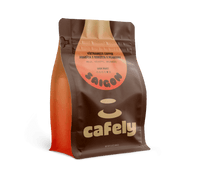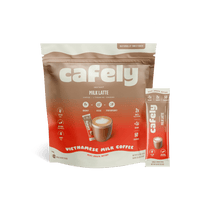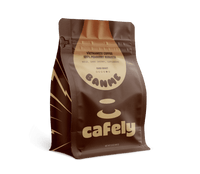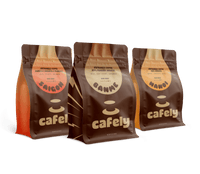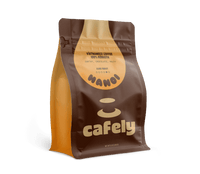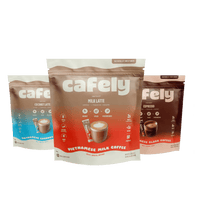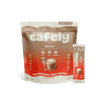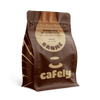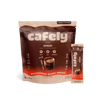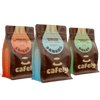Both are comforting, espresso-based drinks, served in cafés around the world. But for many, the actual difference between a cappuccino and a mocha isn’t always obvious, especially if you're choosing on taste alone.
In this article, we’ll break down what sets these two drinks apart from their ingredients and layering to their flavor, texture, and caffeine levels so you can confidently choose the cup that matches your mood.
Cappuccino vs. Mocha: What’s the Core Difference?
At their core, both cappuccinos and mochas begin the same way — with a shot (or two) of espresso and steamed milk. That’s the shared foundation. From there, the paths split, and the defining difference is simple but important…
A mocha contains chocolate. A cappuccino does not.
That chocolate might come in the form of syrup, cocoa powder, or melted dark chocolate, depending on the café or recipe used. But regardless of the format, it gives the mocha a sweeter, richer flavor that blends coffee and chocolate into something closer to a drinkable dessert.
A traditional cappuccino follows a very specific structure:
- 1 part espresso
- 1 part steamed milk
- 1 part milk foam
This 1:1:1 ratio gives cappuccinos their light, airy texture and layered mouthfeel. The foam sits thick on top, and the drink itself feels balanced — not too strong or too creamy. There's no sugar or flavoring added by default, and the drink typically comes in a 5 to 6-oz cup.
A mocha, on the other hand, adds a generous dose of chocolate into the mix:
- Espresso
- Chocolate syrup or powder
- Steamed milk
- Whipped cream or chocolate shavings on top (Optional)
It’s usually served in a slightly larger cup at around 8 to 12 oz, and has a smoother, sweeter profile thanks to the chocolate. Some mochas also include a bit more milk than a cappuccino, creating a thicker, silkier texture that softens the espresso’s natural bitterness.
If you’re deciding between a cappuccino and a mocha:
- Cappuccino = Foam-forward, balanced, no added sugar
- Mocha = Chocolate-forward, sweet, creamier finish
Related: What’s the Best Coffee to Use for Espresso?
Ingredients & Characteristics of Cappuccino

A cappuccino is one of the most recognizable espresso drinks in the world, known for its foamy top and balanced flavor. It’s a staple in coffee shops for good reason — it’s simple, satisfying, and lets the coffee shine without overwhelming the palate.
1. Espresso Base
At its core, a cappuccino begins with one or two shots of espresso. Most cafés use a single shot unless a double (known as a doppio) is requested. This espresso forms the foundation of the drink, delivering a rich, bold coffee flavor.
2. Milk Ratio
What makes a cappuccino unique is its precise milk-to-espresso ratio.
The standard formula is:
- 1/3 espresso
- 1/3 steamed milk
- 1/3 milk foam
This structure creates a drink that’s strong but not overpowering, creamy but not heavy. The steamed milk softens the espresso’s bitterness, while the thick foam adds a textural contrast on top. The foam should be dense, spoonable, and sit firmly above the liquid.
There are slight variations to this classic ratio:
- A “wet” cappuccino has more steamed milk and less foam, resulting in a creamier, softer texture.
- A “dry” cappuccino has more foam and less milk, making the drink stronger and lighter on the palate.
These options cater to personal preferences in mouthfeel and intensity.
3. Texture
Cappuccinos are known for their light yet velvety texture. The steamed milk blends smoothly with the espresso, while the dense microfoam provides a distinct layer that holds its shape. The result is a drink with structure, airy at the top, creamy in the middle, and strong at the base.
When a cappuccino is made well, the foam should not collapse quickly. It acts as both insulation and garnish, keeping the drink warm and offering a tactile experience with each sip.
4. Taste Profile
The flavor of a cappuccino is coffee-forward, with a clean, balanced profile. The espresso is still the star, the milk and foam soften its acidity and bitterness, but don’t overpower it. It’s slightly sweet from the milk’s natural sugars, but not sugary unless the drinker adds a sweetener.
Compared to a latte, which is milkier, a cappuccino feels more intense. But it’s less sweet and rich than a mocha, making it ideal for those who enjoy bold coffee flavor without added syrups or chocolate.
5. Common Variations
While traditional cappuccinos are served plain, some people enjoy them with added flavors.
These might include:
- Vanilla cappuccino
- Caramel cappuccino
- Hazelnut or seasonal flavors
It’s important to note that these are flavor additions, not changes to the structure of the drink. The 1:1:1 ratio typically stays the same, and only the syrup or flavoring is mixed in with the espresso or milk.
Related: How to Make Coffee Syrup (Recipes & Uses)
Ingredients & Characteristics of Mocha

The mocha (also known as a café mocha or mochaccino) blends espresso with chocolate, creating a sweet, rich drink that appeals to both coffee and dessert lovers. It’s indulgent but still rooted in the espresso tradition.
1. Espresso Base
Like a cappuccino, making a mocha starts with one or two shots of espresso. The strength of the coffee can be adjusted based on how strong or sweet the drinker wants the final result to be.
In most cases, a single shot is used for balance, though a double shot is common in larger mochas or café-style servings.
2. Chocolate Element
What sets the mocha apart is the chocolate. This can come in several forms:
- Chocolate syrup (most common in cafés)
- Unsweetened cocoa powder (used in homemade versions)
- Chocolate ganache or melted dark chocolate (seen in artisanal or specialty versions)
- Shaved chocolate (used as a garnish)
The type of chocolate used will impact both the flavor and sweetness of the mocha. Syrup creates a smoother, sweeter drink. Cocoa powder gives it a more bitter, darker chocolate note. Ganache or real chocolate produces a richer, more textured cup.
This chocolate is usually mixed with the espresso before adding the milk, ensuring the base of the drink is well-blended.
3. Milk & Toppings
After the chocolate and espresso are combined, steamed milk is added to the mix. The milk softens the drink, balancing the bitter edge of both the coffee and the chocolate.
If you want to make an iced mocha, skip steaming the milk.
Unlike cappuccinos, which are topped with stiff milk foam, mochas are often topped with:
- Whipped cream
- Chocolate drizzle
- Shaved chocolate or cocoa powder
These toppings enhance the dessert-like appeal of the mocha and add extra sweetness and richness to the experience.
4. Texture
Mochas tend to be creamier and slightly thicker than cappuccinos, especially when made with syrups and topped with whipped cream. The chocolate adds density to the liquid, and the milk-to-espresso ratio is typically higher than in a cappuccino.
In terms of structure, mochas usually skip the heavy foam layer found in cappuccinos. Instead, they rely on whipped cream or microfoam, depending on the preparation.
The result is a drink that feels smooth, soft, and luxurious — almost like hot chocolate with a caffeine boost.
5. Taste Profile
Mochas are known for their rich, sweet, and chocolate-forward flavor. While the espresso still provides depth and bitterness, the chocolate takes center stage. Depending on the recipe, the drink can range from mildly sweet to full-on dessert mode.
Some mochas lean more coffee-forward (especially those made with dark chocolate or less sugar), while others feel like a grown-up hot chocolate with a shot of espresso.
If you prefer a sweeter, indulgent drink, the mocha is your go-to. It satisfies both caffeine and chocolate cravings in one cup.
6. Common Variations
Mochas are one of the most customizable espresso drinks.
Popular variations include:
- White Chocolate Mocha — Made with white chocolate syrup or melted white chocolate. Sweeter and less bitter than traditional mochas.
- Dark Chocolate Mocha — Uses bittersweet or dark cocoa for a richer, deeper flavor.
- Peppermint Mocha — A holiday favorite, combining mint syrup with chocolate and espresso.
- Raspberry Mocha — Adds a fruity twist for those who like tart and sweet together.
- Iced Mocha — Served cold over ice with milk and chocolate syrup.
These variations enable cafés and home brewers to experiment with flavors while maintaining the core formula of espresso + chocolate + milk intact.
Comparing Key Attributes: Cappuccino vs. Mocha

Each drink offers a distinct experience, and depending on your preferences, one may suit your taste more than the other.
1. Flavor Profile
Cappuccino:
The cappuccino flavor is balanced by the steamed milk, but it remains less sweet and more focused on the natural taste of the coffee. Unless sugar or syrup is added, the flavor leans clean and slightly toasty.
Mocha:
It’s naturally sweet thanks to the chocolate syrup or powder, and depending on the recipe, it can feel more like a dessert than a traditional coffee drink. The espresso still adds depth, but chocolate dominates the profile.
2. Texture & Mouthfeel
Cappuccino:
Cappuccinos are known for their layered texture, and you’ll often notice three clear parts — a liquid coffee base, steamed milk, and a thick, airy foam top. This foam gives the drink a light, fluffy mouthfeel and makes each sip feel structured and balanced.
Mocha:
Mochas are generally creamier and denser. The chocolate thickens the base, and many mochas are topped with whipped cream instead of foam, making them feel richer. If you're drinking a mocha made with ganache or melted chocolate, the texture can be even silkier.
3. Sweetness Level
Cappuccino:
A traditional cappuccino contains no added sugar. The sweetness comes solely from the natural sugars in the milk. It’s customizable, and you can add sugar or flavor syrups if you like, but by default, it’s not sweet.
Mocha:
Mochas are typically quite sweet, even before adding whipped cream or extra syrup. The chocolate element brings a natural sweetness, and the use of sweetened syrups or powders pushes the flavor into dessert territory. If made with white chocolate or topped with whipped cream, the sugar content is even higher.
Related: How to Sweeten Your Coffee Without Sugar
4. Caffeine Content
The base caffeine content in both drinks depends on how many shots of espresso are used. A single shot contains about 63 to 70 mg of caffeine. Most standard cappuccinos and mochas use one or two shots, so their espresso-based caffeine levels are comparable.
However, mochas include an extra source: chocolate. Chocolate contains a small amount of caffeine, about 12 mg per tablespoon of cocoa powder or 5 mg per tablespoon of syrup. While this does contribute to the total caffeine, it’s minimal compared to the espresso itself.
In short:
- Cappuccino caffeine — 70 to 140 mg (depending on how many espresso shots are used)
- Mocha caffeine — 70 to 140 mg (slightly higher due to chocolate, but not significantly)
5. Caloric Content
One of the biggest nutritional differences between these drinks comes down to calories and sugar.
Cappuccino:
Made with just espresso and milk, a standard 6-oz cappuccino contains around:
- 60 to 80 calories (if made with whole milk)
- 0 to 1 grams of sugar (unless added by the drinker)
It’s a relatively low-calorie, low-sugar drink, making it a solid option for those watching macros or avoiding sweeteners.
Mocha:
Mochas include chocolate syrup or powder and often whipped cream, which significantly raises the calorie count.
A standard 12-oz mocha can contain:
- 250 to 400+ calories
- 25 to 35 grams of sugar (depending on ingredients and toppings)
Even a small-sized mocha tends to have more than triple the calories of a cappuccino. If health or sugar intake is a concern, it’s something to be aware of, even though lower-calorie mochas can be made by skipping whipped cream and using unsweetened cocoa or plant-based milk.
FAQs: Cappuccino vs. Mocha
Still deciding between a cappuccino or a mocha? These quick answers cover the most common questions people ask.
1. Which Is Stronger, a Cappuccino or a Mocha?
If both use the same number of espresso shots, they have similar coffee strength, even though the mocha may taste richer due to the chocolate.
2. Is A Mocha Just a Cappuccino With Chocolate?
Not exactly. While both start with espresso and milk, mochas include chocolate and usually have more steamed milk and less structured foam than a traditional cappuccino.
3. Does a Mocha Have More Caffeine Than a Cappuccino?
Both have nearly identical caffeine content from espresso. The chocolate adds only a small, negligible amount of extra caffeine.
4. Is Mocha Sweeter Than Cappuccino?
Yes, mochas are typically much sweeter due to added chocolate syrup or powder and, in many cases, whipped cream.
5. What Is the Main Difference In Taste Between a Cappuccino & a Mocha?
Cappuccinos are coffee-forward with mild milk sweetness, while mochas taste sweeter and richer, with chocolate taking the lead alongside espresso.
6. If I Don’t Like Very Sweet Coffee, Should I Choose a Cappuccino or a Mocha?
Choose a cappuccino. It’s not inherently sweet, so you can adjust sugar levels to your taste.
7. Do Both Cappuccino & Mocha Start With the Same Coffee Base?
Yes, both drinks are built on a foundation of one or more shots of espresso.
8. Can I Make a Cappuccino Taste Like a Mocha at Home?
Yes, but once you add chocolate syrup or powder to a cappuccino, it essentially becomes a mocha in both flavor and structure. If you don’t have an espresso machine, you can use instant espresso like Cafely’s Vietnamese Instant Espresso for a quick fix.
9. Which Drink Has More Milk, a Cappuccino or a Mocha?
Mochas often contain more steamed milk and lack the thick foam layer of a cappuccino, making them feel milkier overall.
10. Are There Non-Dairy Versions of Cappuccinos & Mochas?
Yes, both can be made with plant-based milk like oat, almond, soy, or coconut, though foam texture and taste may vary.
